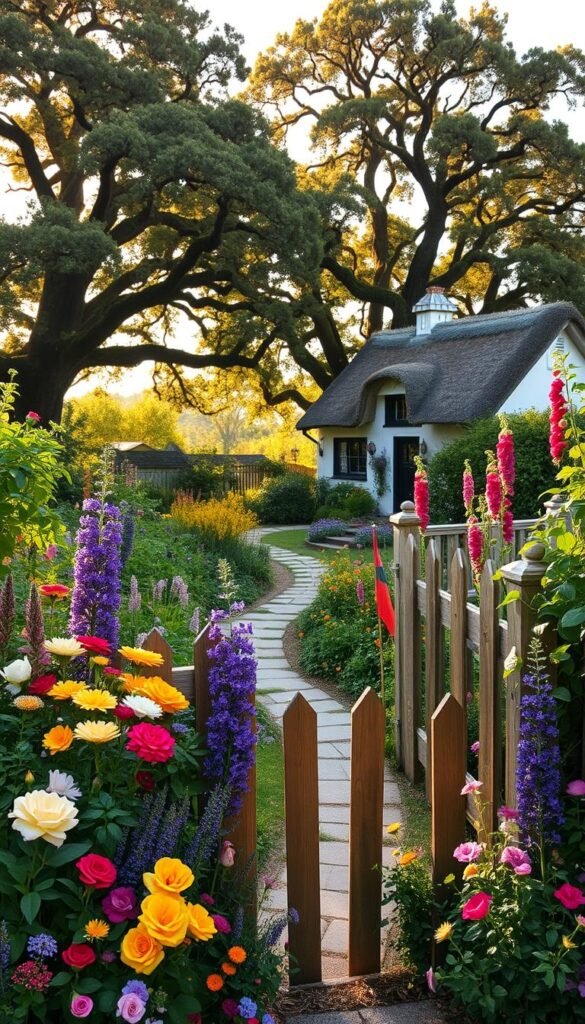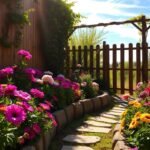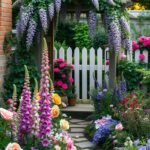Imagine stepping into a space where vibrant colors dance with fragrant herbs, and every path invites discovery. This is the essence of a relaxed, flower-filled landscape that balances wild charm with thoughtful design. Unlike formal arrangements, these spaces celebrate nature’s spontaneity while serving practical needs.
You’ll find that successful designs marry abundant blooms with clever space use. Think climbing roses framing vegetable patches or lavender bordering stone walkways. This approach creates visual harmony while yielding fresh herbs and cut flowers for your home.
What makes these landscapes endure through trends? Their ability to engage all senses. The rustle of ornamental grasses pairs with honeybee hum, while textured foliage contrasts with smooth stepping stones. It’s a living tapestry that evolves with the seasons yet always feels intentional.
Through this guide, you’ll uncover how to layer plants for continuous color and structure. Discover why mixing perennials with self-seeding annuals creates that coveted “effortless” look. Learn to craft inviting nooks where you can savor morning coffee surrounded by nature’s artwork.
Introduction to Your Cottage Garden Journey
There’s something irresistible about spaces that feel both wild and intentional. Picture foxgloves leaning over weathered fences while bees dart between rosemary and sage. This style isn’t about perfection—it’s about creating a living story where every plant has purpose and personality.
Understanding the Charm of Free-Spirited Landscapes
These designs borrow from centuries-old traditions where beauty and practicality walked hand in hand. Farmers once packed their plots with medicinal herbs, vegetables, and flowers—a mix that became the blueprint for today’s layered look. The magic lies in how rambling roses coexist with parsley, or how daisies peek through thyme-covered ground.
Your Path to Effortless Beauty
This guide simplifies the process of crafting spaces that feel both abundant and manageable. You’ll learn to combine self-seeding blooms with sturdy perennials, creating a canvas that shifts gracefully through seasons. We’ll show you how to frame entryways with fragrant climbers and design seating areas that invite lingering moments.
Whether you’re starting fresh or refining an existing yard, our approach focuses on smart plant partnerships and textures that delight year-round. Discover how to turn “controlled chaos” into your home’s most inviting feature—one that welcomes butterflies, neighbors, and quiet mornings alike.
Defining the Cottage Garden Aesthetic
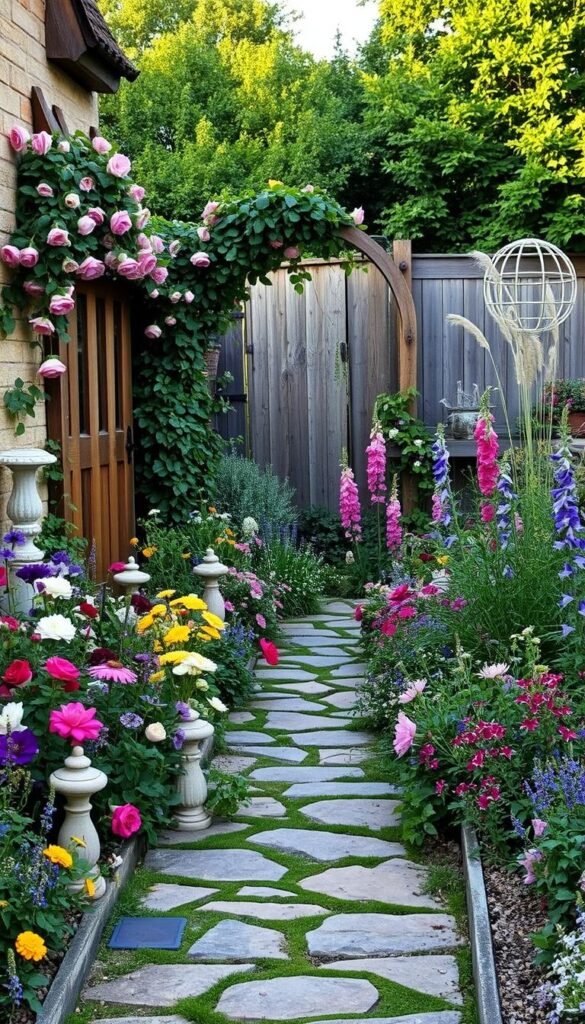
Picture a plot where hollyhocks tower over onion patches, and chickens scratch between berry bushes. This was the reality for early cottage gardeners—spaces born from necessity, not trends. Their charm lies in blending practicality with poetry, where every plant serves multiple roles.
The Roots of Functional Beauty
Originally, these plots were survival tools. Families grew medicinal herbs beside carrots and kept livestock for milk or meat. Fruit trees shaded lettuces, while climbing beans doubled as living trellises. As one 19th-century gardener noted: “A good plot feeds the belly first, then the soul.”
Modern Meets Time-Tested Wisdom
Today’s versions swap pigs for pollinator hotels but keep the spirit of partnership. You’ll design with layered planting strategies—think marigolds deterring pests from tomatoes or lavender attracting bees to apple blossoms. Even small spaces thrive when you mix edible and ornamental plants.
Wildlife elements like birdhouses aren’t just decorative. They’re part of a system where wrens control aphids, and mason bees boost fruit yields. By elevating your space with these features, you create gardens that work smarter, not harder.
The magic happens when rambling roses frame your kale patch, proving beauty and purpose aren’t rivals. Your approach will honor history while adapting to local climates and modern lifestyles—a living legacy in bloom.
Exploring Cottage Garden 101: Basic Principles for Timeless Curb Appeal
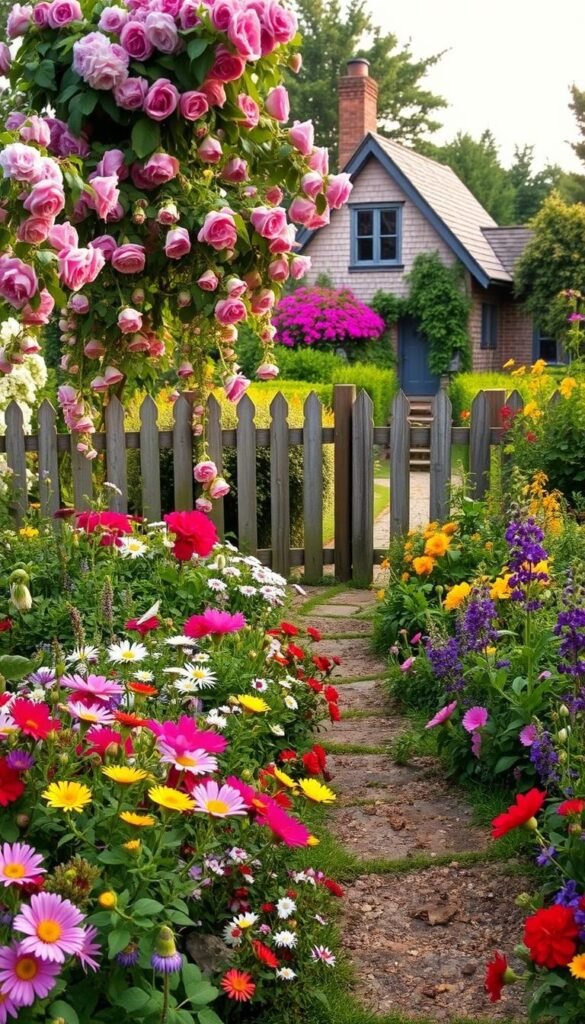
Ever watched sunlight trace patterns across your yard? This observation becomes your first design tool. Emily Smiley from Dennis’ 7 Dees emphasizes:
“Designing begins with understanding your space—track light patterns, test soil, and note existing structures. The magic happens when you weave personal vision into nature’s canvas.”
Your journey starts by balancing wild beauty with intention. Layer foxgloves behind low-growing thyme, letting blooms peek through like hidden treasures. Tall delphiniums might frame a seating area, while creeping phlox softens stone edges. This mix creates depth without rigid lines.
Seasonal rhythm guides plant choices. Spring bulbs give way to summer’s floral fireworks, followed by autumn’s textured grasses. Include self-seeding varieties like cosmos for surprises next year. As Smiley notes, it’s about “curated elegance”—planned enough to thrive, wild enough to delight.
Blend your style with classic charm. A cottagecore aesthetic might feature vintage tools as decor, while modern twists use sleek pots for herbs. Either way, ensure paths invite exploration and nooks encourage pause.
Remember: great designs age like fine wine. They gain character as clematis climbs higher and sage bushes thicken. Your space becomes a living diary, recording years of growth in petals and fragrance.
Selecting the Perfect Plants and Color Palettes
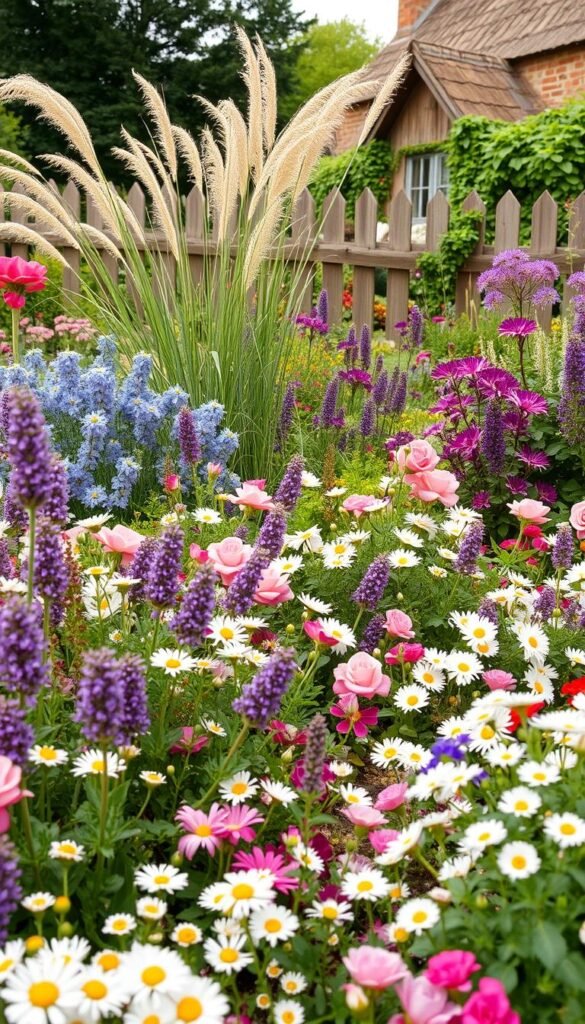
Your plant choices become the paintbrushes that color your landscape’s canvas. Emily Smiley, landscape designer, shares her secret: “Time-tested varieties form the backbone of authentic designs—they’re the storytellers whispering history through petals.” Let’s explore how to mix heritage charm with modern resilience.
Building Your Botanical Dream Team
Start with David Austin Roses—their honeyed fragrance and ruffled blooms anchor romantic corners. Pair them with spiky delphiniums that reach skyward like nature’s fireworks. For late-summer drama, dahlias offer geometric perfection in sunset hues.
Peonies burst with tissue-paper blossoms in spring, while hydrangeas change costumes from pink to blue based on soil chemistry. Foxgloves? They’re the free-spirited poets leaning over paths, their speckled throats inviting hummingbirds to sip.
Weaving Colors Through the Seasons
Smart color schemes work like musical harmonies. Blend cool purples (lavender, catmint) with warm apricot roses for spring. Come summer, let crimson dahlias waltz with buttery daylilies. Autumn calls for burgundy sedum against golden grasses.
Edge sunny beds with silver-foliaged plants—they make colorful container gardening pop. In shade, begonias offer ruby-red leaves while lily-of-the-valley carpets the ground in scented white bells. Remember: repetition creates rhythm. Plant clusters of three matching blooms to guide the eye.
Designing Functional and Whimsical Garden Structures
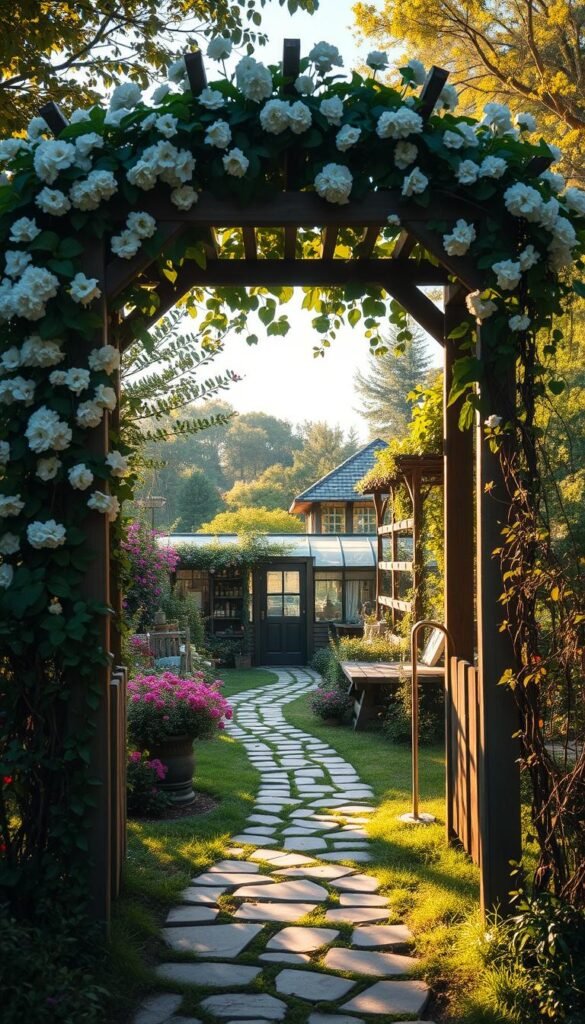
Pathways become storytellers in your landscape, guiding feet and eyes through blooming vignettes. Thoughtful structures transform practical needs into artistic statements, marrying rustic charm with clever design.
Incorporating Walkways, Arbors, and Trellises
Curved paths made of irregular flagstone or crushed gravel slow your pace, inviting discovery around each bend. British horticulturist Geoff Hamilton championed this approach, noting: “A meandering walkway turns a simple yard into an experience.” Pair these with DIY trellises that lift roses skyward, creating living walls of color.
Arbors draped in clematis mark transitions between garden rooms. Use reclaimed wood or wrought iron for posts—their weathered textures blend seamlessly with rambling plants. Obelisks in herb beds add vertical interest while supporting peas or morning glories.
Blending Structure With Natural, Relaxed Elements
Position benches where paths widen, using climbing hydrangeas to soften stone seats. Low fences of willow branches keep herbs contained but visible, maintaining the open, airy feel essential to this style. Gateways framed by arching shrubs create implied boundaries without harsh lines.
Choose materials that age gracefully—lichen-spotted limestone steps, cedar pergolas silvering in sunlight. These elements gain character over time, mirroring your plants’ seasonal transformations. Your design becomes a dance between intention and nature’s spontaneity.
Creating a Modern Cottage Garden Look for Spring Curb Appeal
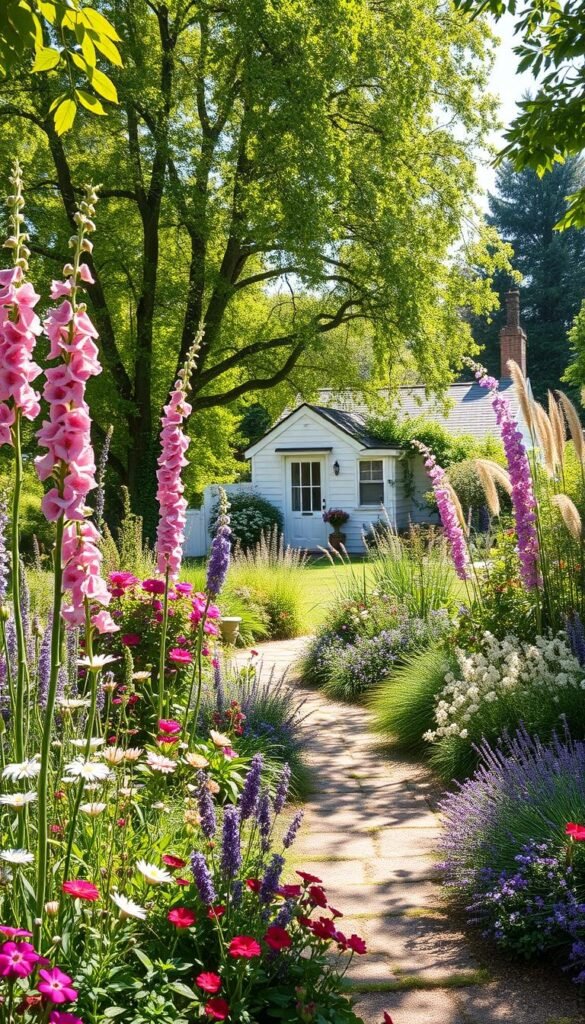
Envision a front yard where heritage blooms meet minimalist design—a space that whispers romance but demands little upkeep. This is the magic of modern cottage gardens, blending nostalgic charm with today’s practical needs. Gone are the days of tangled beds; instead, you’ll craft curated spaces that complement your home’s architecture.
Less Variety, More Impact
Start by choosing 8-10 powerhouse plants that thrive in your climate. Hydrangeas offer months of color, while dwarf boxwoods create crisp borders. Landscape designer Lauren Dunec Hoang suggests: “Limit your palette to three bloom colors for cohesion—lavender, white, and blush pink create instant harmony.”
Mirror your home’s lines with geometric beds or symmetrical pathways. A rectangular herb garden flanking your front steps echoes window shapes, while circular seating areas soften angular rooflines. This structured layout feels intentional yet inviting.
Layer plants by bloom time for nonstop interest. Early tulips pop through silvery artemisia, followed by June roses and autumn sedum. Self-seeding annuals like nigella fill gaps naturally, reducing replanting work.
Add architectural accents that ground the design. A powder-coated steel arbor guides visitors toward your door, while corten steel planters hold evergreen herbs. These modern touches contrast beautifully with billowy peonies or feathery grasses.
Stick to one dominant hue with two accent colors for polish. A sea of white phlox looks crisp against charcoal mulch, while purple salvias repeat in containers and borders. This restraint creates elegance without sacrificing the lushness you love.
Integrating Organic Practices and Wildlife-Friendly Elements
True harmony in your outdoor space comes when nature’s helpers become part of the design. By nurturing soil health and welcoming creatures, you create a living ecosystem that thrives with minimal intervention. Let’s explore how to make your plot a sanctuary for both plants and wildlife.
Working With Nature’s Rhythms
Start by swapping loud tools for quieter alternatives. Electric trimmers instead of gas mowers protect soil organisms essential for plant growth. Feed your flowers and veggies with organic seaweed fertilizer—it’s packed with micronutrients they’ll eagerly absorb.
Build compost bins using cost-effective materials like pallets or wire mesh. Turn kitchen scraps into black gold each spring and fall. This simple act feeds your garden while reducing waste.
Curating Habitat Hotspots
Install a shallow birdbath with stones for perching—dragonflies will use it too. Cluster native plants like milkweed and coneflower to create pollinator buffets. Let deer enjoy tulips safely behind fences, then plant deer-resistant lavender nearby.
Drill holes in untreated wood to make solitary bee hotels. These tiny tenants will boost fruit yields naturally. Remember: every creature plays a role. As aphid-eating ladybugs move in, you’ll see why working with wildlife beats constant battles.
Optimizing Your Planting Space in Containers and Small Gardens
Small spaces hold big potential when you layer plants like a pro. Emily Smiley shares: “Capturing the spirit of a cottage garden on a smaller scale is an exercise in layering and thoughtful plant selection.” Her approach combines vertical drama with ground-level charm, perfect for balconies or petite yards.
Maximizing Impact in Minimal Square Footage
Start with tall, eye-catching plants like dwarf delphiniums or foxgloves in deep pots. Surround them with mid-height bloomers—geraniums and salvias work wonders. Let trailing lobelia or sweet potato vine spill over edges for that effortless overflow cottage gardens adore.
Try vertical tricks from practical container setups. Hang ferns in baskets above thyme-filled window boxes. Stack herb pots on shelves to create living walls. Mix velvety sage leaves with feathery cosmos foliage for contrast.
Choose self-watering pots or drought-tolerant sedums to simplify care. Pair bold purple petunias with silvery artemisia for pops of color that last. Remember: even tiny gardens thrive when textures dance and heights vary.

